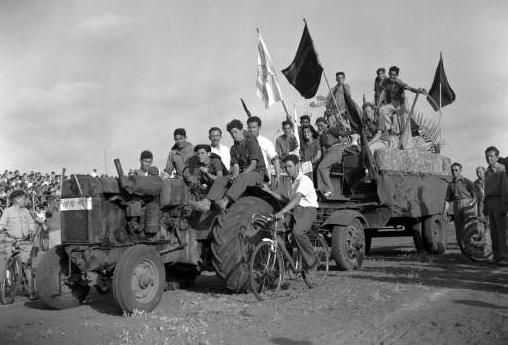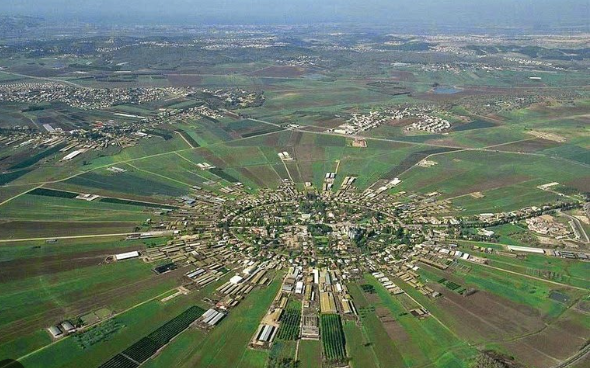What is Kibbutz?
A kibbutz (plural: kibbutzim) is a unique type of collective community in Israel that was historically rooted in the Zionist movement and the desire to establish a self-sustaining, communal agricultural society.
The first “kibbutzim” were established long before the creation of Israel. It was based on a socialist ideology and the promotion of the Zionist idea. A kibbutz was formed as a closely knit social grouping, sharing all property and means of production and labor, while providing for all the needs of the members.
Major decisions in a kibbutz were made collectively by the community members. Decisions were reached through discussion and consensus rather than through hierarchical structures. Kibbutzim provided communal services like education, healthcare, and childcare, for their members.

While initially dependent mostly on agriculture, the kibbutzim later branched into manufacturing and services. For example, Kfar Glickson, a kibbutz in the northern part of Israel’s coastal plain, was established in 1939 by Jewish immigrants from Hungary and Romania. Home to some 300 residents, Kfar Glickson relies on agriculture (field crops, a dairy farm), a small handcraft industry and rural tourism.
Today, there are some 270 kibbutzim in Israel. Most of these unique communities have had to adapt to a rapidly changing social and economic reality and, as Israel became more developed and its economy more liberal, had to compromise on many ideologically based aspects of the original kibbutz.
What is a Moshavim?
A moshav (plural: moshavim) is a unique type of cooperative farmers’ village invented in Israel in the early part of the 20th century. It is characterized by a semi-communal and cooperative structure, where individuals or families own their homes and some property, but they collaborate in certain aspects of life, such as agriculture and infrastructure.
While residents own some of their land, moshavim stresses the need for cooperative farming and agriculture. This means that members work together to cultivate and harvest crops, sharing equipment and labor resources.
Moshavim members make individual decisions regarding their agricultural practices and businesses. They have autonomy over what they grow and how they operate. They can live in their own homes and are not subject to the same level of collective decision-making and uniformity as kibbutzim.

Established as the first moshav in 1921, Nahalal is an extraordinary example of rural planning based on vision and ideology. The village revolves around a circular axis, with the farmers’ houses gathered around a virtual “round table” demonstrating equality and collective reliance. Public buildings are concentrated in the inside of the inner circle, while the agricultural fields spread out in all directions like the rays of a sun. Diverse water sources are used to irrigate the various fields.
Also Read: Difference Between Zionism and Judaism
Kibbutzim And Moshavim: Key Differences
| Basis | Kibbutzim | Moshavim |
|---|---|---|
| Ownership of Property | Collective ownership of property and assets. | Private ownership of property and assets. |
| Economic Structure | Communally organized economy and resources. | Semi-communal economy, but individuals own some property. |
| Work and Labor | Members rotate through various jobs, including manual labor. | Members have specialized roles, such as farming or small businesses. |
| Decision-Making | Decisions are made collectively by the community, often through consensus. | Decisions are made individually or through elected representatives. |
| Social Structure | Emphasizes equality and communal living, with shared facilities and resources. | Places more emphasis on individual and family life, with private homes and resources. |
| Education | Often communal education and childcare provided within the kibbutz. | Individuals are responsible for their children’s education, often in public schools. |
| Lifestyle | Typically more Spartan, focusing on basic needs, with communal dining and shared facilities. | Allows for a more diverse and varied lifestyle, including cooking and dining in private homes. |
| Economic Risk | Shared economic risk and rewards, with members receiving a standard of living stipend. | More personal economic risk and rewards, with income generated individually or as a family. |
| Religion and Ideology | Historically secular and socialist, with a focus on the collective rather than religion. | More religious diversity and tolerance, with a variety of beliefs and practices among members. |
| Historical Development | Developed early part of the 20th century as part of the Zionist movement in pre-state Israel. | Developed later part of the 20th century, with different models evolving in response to changing needs and ideologies. |